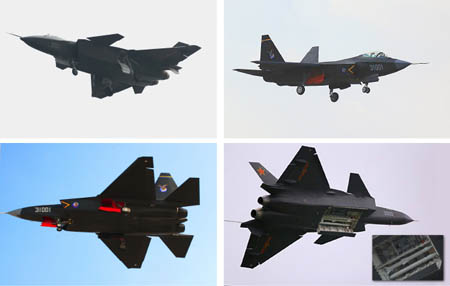
Aug. 28, 2013— say China’s stealth fighter programs represent a significant leap forward for the Chinese military’s technological capabilities, but differ as to whether these programs pose a serious threat to the United States.
say China’s stealth fighter programs represent a significant leap forward for the Chinese military’s technological capabilities, but differ as to whether these programs pose a serious threat to the United States.
In late 2010, images surfaced of what was apparently China’s first, fifth generation stealth fighter prototype, the J-20. At the time, observers highlighted the aircraft’s similarity to that of a decades-old Russian prototype called the MiG 1.42.
In Sept. 2012, photos of what appeared to be China’s newest stealth fighter prototype, the J-31, appeared on the Internet, followed soon afterward by photos depicting the same aircraft during an apparent test flight.
Shortly after the public debut of the J-20 in 2011, US military officials acknowledged that China was closing in on the United States’ technological edge. Rick Fisher, senior fellow at the International Assessment and Strategy Center in Washington, D.C., said that technology gap has narrowed considerably since then.
“Both programs and their successors . . . represent an attempt by China to match and exceed the United States,” Fisher told the Daily Report. “China is not going to settle for parity. Like any great power, China wants its military to be superior,” he said.
Fisher’s comments come in the wake of the release of the Pentagon’s 2013 annual report on China’s military and security developments, which stated that China was developing its stealth fighters in order to “improve its regional airpower projection capabilities and strengthen its ability to strike regional airbases and facilities.”
Fisher believes China’s military capability could eclipse that of the United States by the end of the next decade. The fifth generation fighter programs are “one part of a much larger program to build a globally powerful military capability, and eventually to build a globally dominant military capability,” he said.
Other observers seem more ambivalent about them.
Mark Stokes, executive director of the Project 2049 Institute in Washington, D.C., said in a written response to the Daily Report that “it’s not clear exactly what the PLA [People’s Liberation Army] is doing, and what effect a new fighter would have on air defense systems in the region.” He also noted that China’s aviation industry has tended to be problematic. However, like Fisher, Stokes acknowledged the advances in China’s military technology.
Ross Babbage, founder of the Kokoda Foundation in Australia, similarly refrained from drawing conclusions about China’s stealth fighter programs. “I think it’s a fairly straightforward evolution to develop advanced fighters at this time, but you can’t read too much into it in terms of capabilities,” he said in an Associated Press report late last year.
According to the Pentagon’s China report, China’s stealth aircraft are not expected to be operational before 2018.
(DOD’s 2013 China report; caution, large-sized file.)